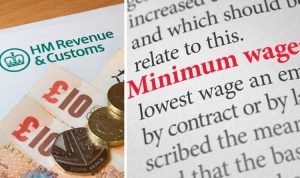No, it’s not the Cattle Information Service. Or the Care Identity Scheme. In our world, it’s the Construction Industry Scheme. 🔨👷♂️
It’s HMRC’s way of saying “we don’t trust anyone who works in the construction business”. Sorry, but that’s the short of it. 😒
I don’t personally believe the trades are any more or less dishonest than any other profession, but our friends at the Treasury don’t agree.
The upshot is, if you’re caught under CIS then it means your contractor will deduct tax at source from your invoice and pay the tax over to HMRC on your behalf. It means you get less cash in your pocket today, and you have to wait until the end of the tax year to get your refund.
But are you caught under CIS?
Broadly, CIS only applies to people working:
– on a self-employed or Limited Company basis
– for a contactor, and
– on a construction project
If you’re genuinely employed, or making materials offsite, of if you’re working directly for the property owner, you can stop reading now…
Still with us?
The most popular CIS example is housebuilding, but the same applies to the construction of commercial or industrial buildings, or civil engineering. Demolition is also covered.
And it’s not just the physical construction that’s caught under CIS – if you’re painting, putting down lino, or installing a kitchen in a new property, it’s all under CIS.
What’s Exempt?
There are some simple rules here: anything you do to an existing property e.g. replacement of a kitchen or putting on some solar panels, you’re fine BUT if you’re dealing with an extension of a property, or a total refurb, say hello to CIS again.
Of course, this leads to the question of “When does a repair become an extension” – it can be a grey area, so get confirmation from your contractor before you start the job, to help you budget for your cashflow.
All materials – assuming they are invoiced separately – are exempt too. The aim of all this is to tax just labour income, rather than recharges of goods/materials.
Professional services like – engineers, architects, surveyors etc are always exempt, as is most equipment hire. 👨💼
Naturally, there’s a raft of quirks and exemptions, so get in touch if there’s something specific you want to look at. 🔎
Luckily (or perhaps not?) for subcontractors, it’s the responsibility of the main contractor to decide what work is covered under CIS, and what’s exempt. But as a subbie, it’s good to have a working knowledge of the rules, because contractors (sorry!) often get it wrong.
Bummer. I’m caught under CIS. What happens now?
I’m afraid you need to prepare for a deduction of either 20% or even 30% from your pay packet. All isn’t lost, of course – when you prepare your tax return, you get credit for all the tax deducted from your pay. But it will certainly hit your cash flow in the meantime. 💰
BUT MAKE SURE you get a statement each week or month with your pay, showing the amount deducted. If you lose this, you’ve no way to prove you’ve had the tax already deducted. That could work out very expensive.
And if your contractor “forgets” to give you a deduction statement, alarm bells should sound. We’ve seen it a couple of times with our own clients where the contractor said they had deducted 20% tax but never paid that over to HMRC, nor did they give our clients a statement for the deduction.
It’s outright fraud, pure and simple. 👮♂️
So don’t be fobbed off into accepting your pay without a written statement of the CIS tax deducted: the law requires your contractor to give you this statement by e.g. 21st of January for your December deductions.
20% or 30%? You Choose…
As a subbie, you should register with HMRC for CIS status – either via the government gateway, over the phone with HMRC (if you like being on hold for a loooooong time 😬) or via your accountant.
When you start work for your contractor, give them your UTR and National Insurance number, they’ll check it with HMRC and – assuming you’ve registered for CIS – they’ll be told to deduct 20%.
If HMRC don’t have you as CIS, they’ll instruct the contractor to deduct a massive 30% from your pay.
Ouch!
How does ZERO deductions sound?
If you’re all up to date with your taxes and there’s no black marks on your tax record, you can apply for “Gross Payment Status” i.e. to have no CIS deducted whatsoever.
HMRC aren’t obliged to grant you this, and you’ll lose it the moment you pay your tax – or submit a tax return – late. And don’t bother applying for this until you’ve been subbing for at least 12 months.
But…in truth…we actually see very few clients opting for Gross Payment Status. Here’s why:
What happens at tax return time?
So you’ve worked hard all year and never got to enjoy 20% or 30% of your day rate?
Now is your time to shine!! 💡
When we prepare your tax return, we’ll work together to ensure we end up at the lowest (legal) amount of tax for the year. For most CIS clients, this figure is usually LOWER than the amount of CIS you’ve had deducted from your invoices.
So it doesn’t take an accountant to know that means you’re about to get a TAX REFUND. 💲💲
Hence, the sooner after the 5th April each year we can complete your return, the sooner you’ll get your refund.
On the flip side, if you’ve opted for Gross Payment Status and there’s been ZERO tax deducted during the year, then I’m afraid now is the time to pony up and dig deep, because your annual tax bill is going to land in one hit. 😬
Hence, most clients see CIS as a sort of piggy bank savings account, having money deducted that you never see each month and then getting a little back at the end of the year to put towards your summer holiday, some shiny new tools or whatever else takes your fancy.
What Next?
If you don’t have an accountant on your side, working to maximise your tax relief each year and guaranteeing to prepare and file your return within just a few weeks of being provided with the information, it’s time to sort that out.
But if you’re flying solo – or spending every month chasing your accountant for answers – it’s time to speak to Mark Ferbert, our tax manager, and see if it’s time to join Team Penguin.


